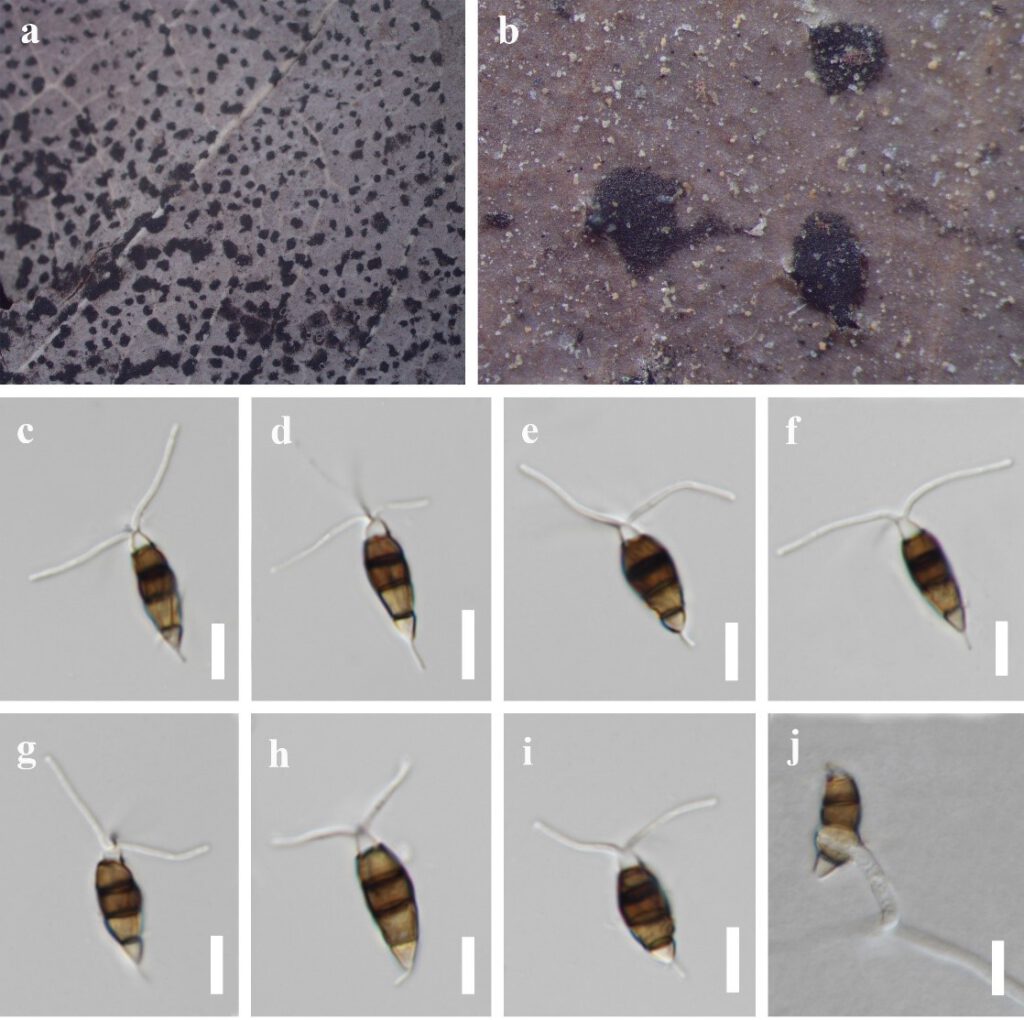Neopestalotiopsis subtropicalis Y.R. Sun &Yong Wang bis, sp. nov. Fig. 7
MycoBank number: MB; Index Fungorum number: IF; Facesoffungi number: FoF 12915;
Etymology – Referring to the subtropical regions in which the collections were encountered.
Holotype – MFLU 22-0XXX
Saprobic on Ceiba pentandra leaves and endophytic from Pinellia ternata. Sexual morph: Not observed. Asexual morph: Conidiomata solitary, unilocular, dark, immersed on stems. Conidiophores indistinct, often reduced to conidiogenous cells. Conidiogenous cells indistinct. Conidia 19–24.5 ×6.0–8.0 μm ± SD = 21.5±1.2 × 7.0 ± 0.6 μm (n = 30), L/W ratio = 3.1, fusoid, ellipsoid to subcylindrical, straight to slightly curved, 4-septate; basal cell conic to obconic with a truncate base, hyaline to subhyaline, 3–5.5 μm long; three median cells 13.0–15.2 μm long ( ± SD = 14.0 ± 0.6 μm), wall rugose, versicolourous, septa darker than the rest of the cell; second cell from base pale brown to brown, 3.5–5.0 μm long; third cell brown, 3.5–5.5μm long; fourth cell brown, 3.0–5.5 μm long; apical cell 2.5–4.0 μm long, hyaline, rugose and thin-walled; with 2 (seldom 3) tubular apical appendages, arising from the apical crest, unbranched, filiform, 11.5–20.0 μm long; single basal appendage 2.0–5.0 μm long, unbranched, tubular, centric.
Culture characteristics – Colonies on PDA reaching up to 8 cm in two weeks, dense aerial mycelium on the surface with undulate edge, white. Fruiting bodies were observed after 14 days.
Material examined – Thailand, Chiang Rai Province, dead leaves of Ceiba pentandra (L.) Gaertn. (Bombacaceae), 16 Jan 2021, Y.R. Sun, CR20 (MFLU 22-xxx, holotype); ex-type living cultures, MFLUCC 22-xxx. China, Guizhou Province, Guiyang City, Nanming District, Guiyang Medicinal Botanical Garden, on healthy leaves of Pinellia ternata (Thunb.) Breit. (Araceae), 1 May 2022, Y.R. Sun, E2 (HGUP 22–xxxx, paratype); living culture GUCC 805.
Notes – Our isolates GUCC 22-xxxx and MFLUCC 22-xxx clustered together with Neopestalotiopsis sp2 (CFCC 54340 and ZX22B) and these four isolates formed a distinct clade in the phylogenetic tree (Fig. 1). Four isolates have similar characteristics. The PHI test on N. subtropicalis indicated that there is no significant recombination (Фw = 1.0), between N. subtropicalis and its closely related taxa (Fig 2c). Hence, we identify N. subtropicalis as a new species. Interestingly, GUCC 22-xxxx, MFLUCC 22-xxx, ZX22B and CFCC 54340 have different habitats. GUCC 22-xxxx was endophytic in healthy leaves of Pinellia ternata, MFLUCC 22-xxx was saprobic on decaying leaves of Ceiba pentandra, and CFCC 54340, ZX22B were isolated from leaf spots of Castanea mollissima. This seems to indicate that the same species has different lifestyles in different hosts or regions.

Figure 7 – Neopestalotiopsis subtropicalis (MFLU 22-xx, holotype). a, b Conidiomata on the host. c–i Conidia. j Germinated conidium. Scale bars: c–j = 10 µm.
